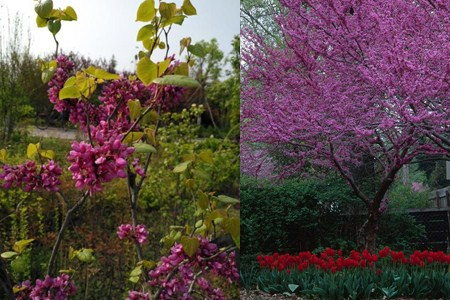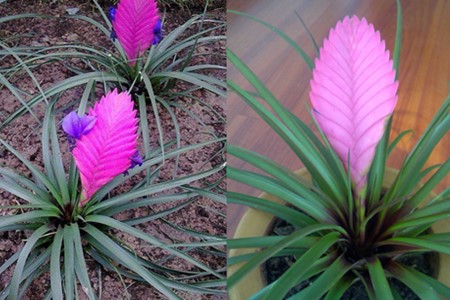How to raise wisteria bonsai and teach you how to do it easily in six steps

Wisteria is named for its color and shape. It has high ornamental value and is loved by many friends. I heard a lot of people praise it before. After seeing the wisteria bonsai, I also became a person who loved it. So, how on earth should wisteria bonsai be kept? Next, let me share with you the culture method of wisteria bonsai.
It is very important to select seedlings for planting wisteria bonsai. In fact, if you choose seedlings, you can take any method, but in most families, bonsai seedlings are purchased directly from the florist, so the survival rate will be higher. But there are also a small number of "experts" who like to cultivate from the seeds.
First, Miao Yuan.
The methods of sowing and cutting propagation can be carried out. Sowing time can be in early spring, the temperature is required to be between 10 ℃ and 13 ℃. If it is cutting propagation, it can be carried out in autumn.
Second, making wisteria bonsai.
1. Put on the basin.
It is better to plant in spring, that is, February-March. Pot soil we should use more fertile, good drainage of rotten leaf soil and soil mixed. Good flowers should be made in pots. We can choose some deeper, more atmospheric-looking basins, which can be angular or circular in shape.
2. Modeling.
We give priority to pruning and finishing, followed by binding, the purpose of which is to fully express the simple and beautiful natural form of plants. When pruning, the branches should be scattered in order to avoid monotony, but not too many layers. We see a variety of wisteria bonsai forms. In this respect, you can use your imagination and make a good-looking look.
3. Watering.
We will find that it consumes a lot of water, but even so we can't water it often. If it is only wet but not dry, it is not conducive to flowering. When it comes to watering, don't water it until it's dry. Water must be thoroughly watered. Especially in August, there should be less watering. Normal watering can be carried out in September.
4. Fertilization.
The frequent application of thin fertilizer is a key point to make wisteria blossom and blossom, so remember. During the growing period of the plant, we can water it according to the situation, and we can put the cake fertilizer with relatively low concentration every half a month. We don't stop fertilizing until July-August, and we have to continue to apply fertilizer in September. However, the frequency and concentration should be reduced appropriately. Before flowering, we can appropriately increase the number of times of phosphorus and potassium fertilizer application depending on the situation.
5. Pruning.
When wisteria sprouts in spring, it is necessary to pick the shoots properly. When the new branch grows to more than 20 centimeters, we can cut off the overlong new branch. September is the period when the old leaves of wisteria are easy to age and droop, because it will affect their appearance, so we can pick off the old leaves to speed up the germination of new leaves. The germinated new leaves are relatively tender, which can effectively postpone the defoliation period and prolong the viewing period of bonsai.
6. Turn the basin.
It would be better to turn the basin before the sprouting of early spring. After that, you can turn the basin every two or three years.
Third, pest control.
Compared with other flower plants, wisteria has fewer pests. But pests are everywhere, and aphids and leaf moths are the pests of wisteria. Our prevention and control method is mainly to spray trichlorfon and emulsified dimethoate and other insecticides.
These are all I have shared about growing wisteria bonsai. Is there anything I can do to help you after watching it?
How to raise wisteria bonsai
How to raise wisteria bonsai
Wisteria has deep main roots and few lateral roots. Like sunshine, slightly shade-resistant, cold-resistant, drought-resistant, adaptable; like deep, fertile, loose, well-drained soil.
The old trees used to make wisteria bonsai are more than those dug from the mountains in spring, and according to the modeling needs, the main roots are cut short to form naked and bare roots, which are then processed into curved or oblique type, hanging branch type, cliff type and so on. The stump is planted in a deeper, slightly larger culture pot. After placing it in the shade for a week, move to a place where you can get sunlight in the morning. Through I-year culture, the root system is developed, more lateral roots, branches and vines grow vigorously, which is beneficial to root lifting, pruning and changing pots. In the second year, the tree pots were turned over before sprouting and transplanted into the ornamental basin. And then styling. You can enjoy it after maintenance.
It is appropriate to choose a deeper round or square Yixing purple sand basin or Foshan bonsai basin. Pot soil uses sun-dried pond soil, vegetable garden soil, or rotten leaf soil.
When turning the basin, the tree stalk should be trimmed once, the rattan stem should be cut short, the overdense rattan branches on the stem should be thinned, and the transition point between the apical branch and the stem should be dealt with. You can lift the root properly when you put it on the basin, and put it in a sunny place after putting it on the basin.
Wisteria likes fertilizer, the growth period should often apply thin and rotten organic fertilizer, in addition to the flowering period, apply liquid fertilizer once a month. Water regularly to keep the basin soil moist. Pay attention to water control after autumn to prevent autumn shoots from sprouting and growing, trees are too prosperous, too many branches and leaves are not easy to blossom.
The modeling uses the combination of bud picking, heart picking and pruning and climbing. After sprouting in spring, each branch leaves 2-3 buds, and when the new shoot grows to 15 cm, it picks the heart, promotes the formation of flower branches, blossoms at the top of the new shoots, and blooms like flowers when it blossoms. During the dormant period, short branches should be cut, the distribution structure of branches should be adjusted and the shape should be kept beautiful. At ordinary times, it is necessary to prune overgrown, overdense and overlong drooping branches to concentrate nutrients on the flower branches.
When the flowers fade, they should be cut off in time and their branches should be cut short. Turning the basin and changing the soil once a year should be carried out before the sprouting of the first branch. Turn the basin and cut off the old and overgrown roots at the same time, and replace half of the old soil. Add loose, fertile soil and base fertilizer. By turning the basin and changing the soil, it can increase nutrients and enhance the tree potential, so as to accumulate nutrients and promote more flowering.
Wisteria twigs are vulnerable to aphids and are sprayed with 40% dimethoate 800 times when found. When it is found that the leaves are eaten by night moths, 50% dichlorvos 1000 times solution can be sprayed in the evening.
In sufficient sunshine, as long as timely supply of water and fertilizer, timely heart, bud, do a good job after flowering and dormancy pruning. Changing soil, pruning roots and adding base fertilizer every year, wisteria will blossom year after year after modeling and proper maintenance.
Wisteria bonsai
Wisteria bonsai
- Prev

Beginners need to master these culture skills on how to prune the bauhinia tree.
Bauhinia tree, alias bare branch tree, purple bead, Latin name Cercischinensis. Leguminosae, Bauhinia. Distributed in most provinces of China, it has excellent ornamental value and application value. Like light, have strong cold resistance
- Next

After the purple pineapple turns green, how to raise a trick to make you a master flower grower?
Purple pineapple, hear this name to know that it must be purple, but it is not always purple, it will also turn green. When it turns green, it means it's going to wither.
Related
- Fuxing push coffee new agricultural production and marketing class: lack of small-scale processing plants
- Jujube rice field leisure farm deep ploughing Yilan for five years to create a space for organic food and play
- Nongyu Farm-A trial of organic papaya for brave women with advanced technology
- Four points for attention in the prevention and control of diseases and insect pests of edible fungi
- How to add nutrient solution to Edible Fungi
- Is there any good way to control edible fungus mites?
- Open Inoculation Technology of Edible Fungi
- Is there any clever way to use fertilizer for edible fungus in winter?
- What agents are used to kill the pathogens of edible fungi in the mushroom shed?
- Rapid drying of Edible Fungi

